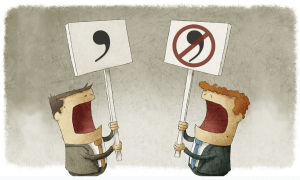The Oxford Comma, or serial comma, is used before the final conjunction in a list of items. An example being “I have a dog, a cat, and a turtle.” The Oxford comma is the second comma in the phrase, coming right before “and a turtle.” It is used in English grammar as a method of providing clarity and structure to writing. A highly controversial grammatical subject, people very strongly believe that the comma should always either be included, or omitted.
Proponents of the Oxford comma argue that its use provides clarity and consistency to writing. Without the comma, it is easy to misconstrue the meaning of a sentence, thus altering its message. For example, take: “I love my parents, Jennifer Coolidge, and Liam Hemsworth.” The comma before “Liam Hemsworth” is essential, it clarifies that the author loves their parents, as well as Jennifer Coolidge and Liam Hemsworth. Without it, the sentence would read “I love my parents, Jennifer Coolidge and Liam Hemsworth.” This structure creates confusion, as it seems as though the author is saying their parents are the two actors. As such, the Oxford comma provides an essential clarification.
If this sentence was read aloud, most people would understand its meaning regardless of the comma, however it is important to note that “The purpose of commas is to separate and indicate short pauses between clauses” (Oxford Royale). If we want to follow the correct grammatical structure, the use of the Oxford comma is essential.Another argument in favor of the use of the Oxford comma is that it provides consistency across writing.  Most major style guides in the United States mandate its use, such as the Chicago Manual of Style, the Modern Language Association (MLA), and the American Psychological Association (APA). These guides are incredibly influential in the literary world, and those in favor of the comma would argue that its use provides an essential consistency to writing.
Most major style guides in the United States mandate its use, such as the Chicago Manual of Style, the Modern Language Association (MLA), and the American Psychological Association (APA). These guides are incredibly influential in the literary world, and those in favor of the comma would argue that its use provides an essential consistency to writing.
Opponents of the Oxford comma contend that its use is unnecessary, and should be omitted for the sake of simplicity. Take the phrase “I am going to the school, the store and my house.” In this case, the use of a comma after store would be redundant, anyone would be able to understand the author’s meaning regardless of punctuation. Jocelyn Huang states “Another reason to skip the Oxford comma is to save time, both for the writer and reader.” (Huang). She argues while implementing the comma may only take a moment of the author’s time, that time builds up. Furthermore, people don’t usually read things differently regardless of comma usage. It is also important to note that while many major style guides mandate the use of the Oxford comma, the Associated Press (AP) does not.
Ultimately, I believe that it is always better to err on the side of clarity. Implementing the comma doesn’t have the possibility of confusion or negative repercussions as choosing to not implement it might have. As even the anti-Oxford comma Associated Press states, “punctuation is to make clear the thought expressed” (AP). In this case, why omit the comma and potentially cause confusion?
Works Cited
Huang, Jocelyn. “The Case against the Oxford Comma.” The Daily Californian, 28 Feb. 2020, dailycal.org/2020/02/28/the-case-against-the-oxford-comma.
Associated Press Stylebook, www.apstylebook.com/. Accessed 13 Nov. 2023.
Oxford Royale. “What Is the Oxford Comma?” Oxford Royale, 17 Mar. 2022, www.oxford-royale.com/articles/oxford-comma/.
